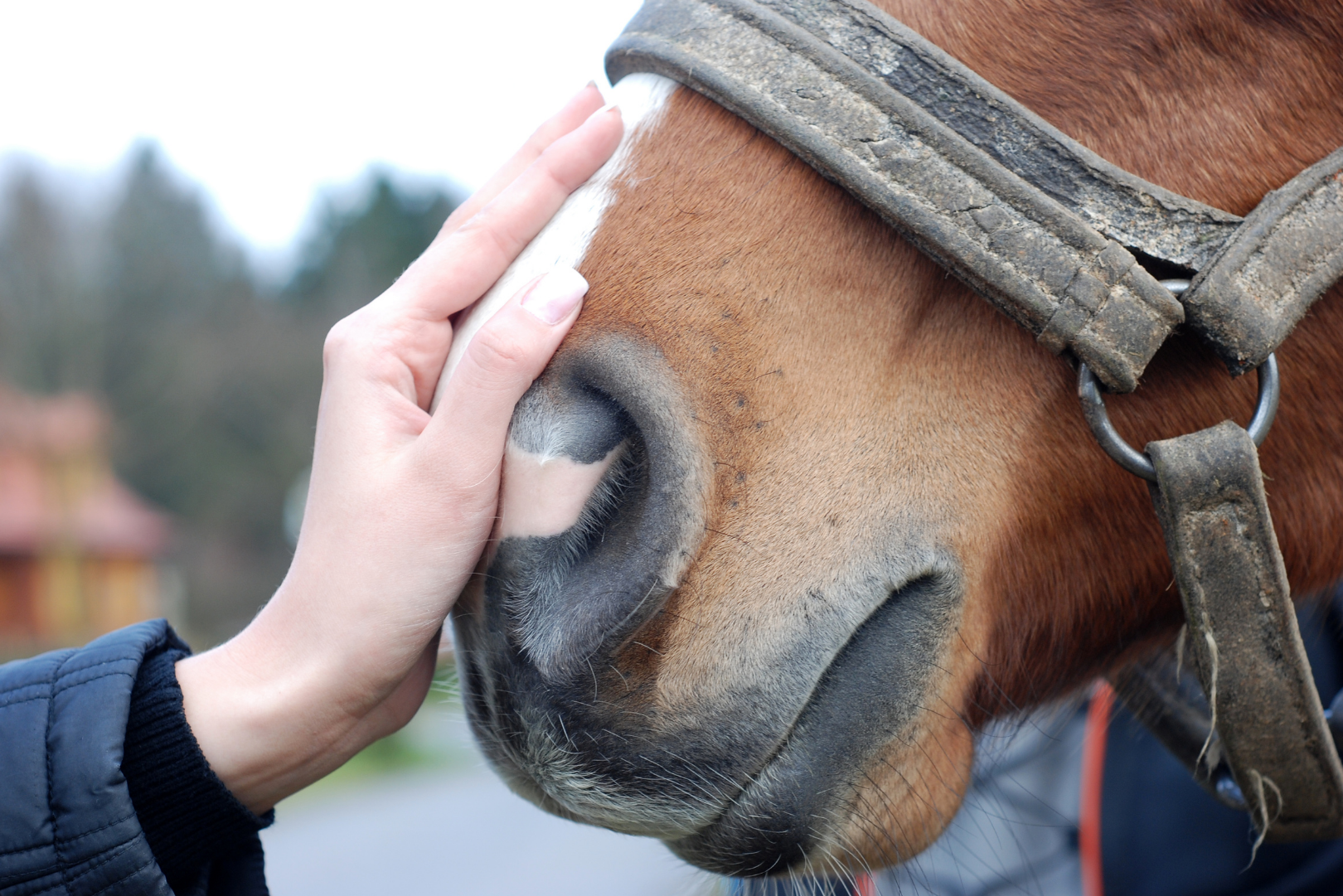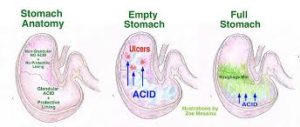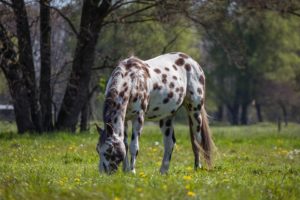
18 Mar 2021 Preventing Ulcers Through Nutrition
 One of the most common ailments horses face is the presence of ulcers. They can affect any horse at any age. Up to 9O% of racehorses and 6O% of show horses, as well as pleasure horses and foals suffer from ulcers. Some horses even suffer from them chronically.
One of the most common ailments horses face is the presence of ulcers. They can affect any horse at any age. Up to 9O% of racehorses and 6O% of show horses, as well as pleasure horses and foals suffer from ulcers. Some horses even suffer from them chronically.
Let’s have a closer look at what they are, how you can identify them, how to treat them and most importantly how you can prevent them.
What are Ulcers?
While ulcer lesions can occur along most of the digestive tract of the horse, including the mouth, the stomach is the most common site of gastric ulcers in an adult horse. We can distinguish different ulcers depending on the location of occurrence.
Mouth
Ulcers in the mouth, also called blisters, are often overlooked and may occur due to several causes such as dental problems, viral infections, caustic chemicals, harmful plants such as buttercups, foxtail or Sandbur or evenby improperly fitting tack.
Stomach
Gastritis, or inflammation of the stomach lining, is a condition caused by an underlying disease and in many cases is man-made. Ulcers in the mucus membrane of the stomach are a stage of gastritis.
The horse’s stomach can be divided into two parts and ulceration in either needs to be distinguished .

The bottom part is glandular and secretes acid. It has a protective coating or mucosal lining to keep it from being damaged by this acid. Ulcers occur here when the mucosal lining deteriorates, although this is less common. Scientists are not entirely sure what the causes are, but they believe that high dosages or long-term use of non-steroidal anti-inflammatory drugs (NSAIDs) such as Bute, may reduce the blood supply to the lining and contribute to the break down. Scientists also suspect bacterial infection could be another cause.
The top third of the stomach does not have this protective coating and is more prone to ulceration. Horses have acid in their stomachs that helps them digest food, specifically starches. But when there is no food in the horse’s stomach, the acid can start to burn the lining and in extreme cases even lead to perforation of the stomach lining, which is almost always fatal. Bacteria or parasites also can damage this area of the stomach as can splashing of stomach acid onto this area of the horse’s stomach.
Hindgut
Ulcers can also be present in the colon, or hindgut. They often go hand in hand with gastric ulcers and are much harder to diagnose. Overuse of NSAIDs, parasite burden, or a condition called hindgut acidosis are common causes for colonic ulcers. Hindgut acidosis is an excessive acidity in the horse’s hindgut due to a drastic drop of the pH value, most commonly caused by a high grain and low forage diet.
Contributing factors
 Now that we understand what ulcers are, let’s delve into the possible precursors for the development of gastric and colonic ulcers.
Now that we understand what ulcers are, let’s delve into the possible precursors for the development of gastric and colonic ulcers.
Unfortunately, ulcers are largely caused by humans and due to the unnatural way most horses are kept. The good news is that once we are aware of these factors, we can strive to eliminate or alleviate them.
Feeding
Feeding is perhaps the most important factor in the development and at the same time prevention of ulcers in horses. The horse is designed to spend 2O to 22 hours per day foraging for food. Small quantities all the time. Chewing produces saliva, the only natural source of anti-acid the horse has to prevent inflammation and irritation in the digestive tract. Having feed matter passing through the stomach also helps to soak up stomach acids, and creates a food “mat” which limits the splashing of acids onto the top unprotected part of the stomach.
When horses are fed only 2 times a day with limited access to grass or hay in between mealtimes, they go for a prolonged period (over 4-6 hours) without feed to neutralize the acid. Furthermore, if the feed contains grains which produce volatile fatty acids (through digestion of starches), stomach acidity is made much worse. Especially if the meals are quite large, the transit time in the stomach and small intestine is too short for all starches to be digested and they enter the hindgut only partially digested. There the starches will cause a drop in the pH of the hindgut causing more damage and possible colonic ulcers.
Housing
Keeping horses in stalls, restricting their movement, and isolation from other horses may trigger ulcer formation. Research shows that the more hours in a day that horses spend in stalls or small spaces, the higher the risk of ulcers becomes.
 Transportation
Transportation
Horses traveling for training, clinics, or shows spend long hours with limited access to forage, and horses don’t eat as much as they would normally even if hay bags are provided and kept full. Being in a moving trailer reduces their appetite, and the stress of a new environment and stable makes horses more prone to developing ulcers while traveling.
Strenuous exercise
Moderate to intense exercise may decrease the emptying function of the stomach and blood flow to the stomach, increasing the acidity problem. In addition, exercise causes the acid content in the lower part of the stomach to splash upward, potentially damaging the upper portion of the stomach.
Medications
Prolonged use of corticosteroids, non-steroidal anti-inflammatory medications, or NSAIDs like Bute and other medicines can predispose horses to gastric ulcers. Owners should consult with vets and be wary of using long-term medications. Learn more about a nutrition first approach to long-term health issues.
 How do I Know if my Horse has Ulcers?
How do I Know if my Horse has Ulcers?
There are some common behavioral signs you can look out for that show your horse is having abdominal discomfort which could be caused by ulcers.
Girthiness, pinning ears when brushed/curried on gut or girth line, biting when tacking up, bucking or rearing, arching back/pinning ears when you mount, reduced stride length, diarrhea or loose stools, change in behavior or attitude, cribbing, poor appetite, intermittent colic, dull coat, kicking or biting at stomach, and losing weight are all potential signs of ulcers.
How to Diagnose Ulcers?
While outward behavior can help you identify gastric ulcers, the only way to know for sure if your horse has ulcers is through a gastroscopy or ‘scope’ performed by your veterinarian. This is the best way for your veterinarian to accurately diagnose the presence, location and severity of ulceration in the stomach. A gastroscopy cannot however determine additional conditions such as parasites in the hindgut.
How do I Prevent Ulcers?
Remembering that ulcers form when gastric acids build up and attack the intestinal linings, there are some lifestyle changes you can implement to help prevent ulcers in horses. They all aim to remove the predisposing factors.
Free Choice Hay/Grazing
The best way to prevent ulcers in horses is to supply free choice grazing or hay so that they continuously product saliva as a natural anti-acid through chewing, and so their stomach is never empty. If you are concerned about your easy-keeper getting overweight, it would be better to feed more of a less nutritionally-dense hay perhaps with a slow feed hay net, rather than one or two flakes of highly caloric hay and interruptions for large portions of the day.
Lowering Stress
 Stress can come from many areas in your horse’s life and can contribute to gastric issues. If you’re traveling to shows or clinics, make sure to provide forage during the journey or shorten/split up the travel time.
Stress can come from many areas in your horse’s life and can contribute to gastric issues. If you’re traveling to shows or clinics, make sure to provide forage during the journey or shorten/split up the travel time.
If the neighboring horse at home or at shows kicks the walls a lot, your horse will be more stressed. Plan ahead and request a corner or end stall even if it means walking further to and from the show grounds.
You can lower pasture stress by not feeding horses their meals in group environments, where there’s the threat of other horses stealing their food, and by making sure that their pasture relationships are harmonious and quiet. Horses also get stressed when they don’t have a companion, so keeping one horse alone on a property is not ideal for ulcers.
Keeping Training Progress Gradual
Similarly, keep your exercise sessions with your horse as low-stress as possible. Shorter sessions and in between-days when horses go on a hack or trail ride can be helpful. Remember that stomach acids are tossed around during exercise, so it is a good idea to offer them forage before riding.
Less time in stalls
Research has shown that the more hours a horse spends in a stall, the higher the rate of ulcers. Stall boredom can also contribute to behaviors like cribbing and weaving. Being in a stall comes with an inherent amount of stress for a grazing animal like a horse.
Feed Little and Often
Horses are designed to be eating a little bit nearly all the time. It is healthier for them to be fed several small meals throughout the day than one large meal containing a lot of ‘hard’ feed. You can also help lessen the gastric impact of mealtimes of all sizes on your horse by providing continuous free choice hay.
What to do When your Horse has Ulcers?
First and foremost, talk with your veterinarian to see if you need to give your horse any medication to alleviate the pain associated with ulcers or to help your horse heal the lesions.
Feeding a horse correctly will have a great impact on the healing and prevention of ulcers. Some foods are much better at ‘buffering’ stomach acids than others. But remember that foremost, the production of saliva is the best anti-acid and the most important line of action. Chewing is the only thing that leads to the saliva production in horses, so continuous access to forage is key.
If your horse has a heavy enough workload, you may need to supplement forage with ‘hard feed’. There are certain types of food which are much better for your horse and can help you prevent ulcers through nutrition.
Best Feeds to help Prevent Ulcers
Alfalfa
Providing long stem, leafy hays that take a longer time to chew, like alfalfa, will lead to a longer production of saliva. Saliva contains bicarbonate, which buffers and protects your horse’s stomach. Alfalfa itself is a fantastic ingredient for preventing ulcers because of the high calcium which acts as an anti-acid. It can be fed in flakes of hay, or in other forms like chopped cubes or pellets. As a nutritionist, I frequently include soaked alfalfa into the diets I create. I like to use pellets so I get a more consistent quality and control over the quantity for my horses and my clients’ horses.
 Beet Pulp
Beet Pulp
Similarly, beet pulp is a great ulcer-preventing ingredient. The high fiber means that food passes smoothly through the digestive tract where it spends most of its time, and because it’s soaked, it adds extra hydration to the digestive system. Feeding beet pulp is associated with a lower risk of glandular ulcers according to many research studies and is definitely something you should consider for your horse. I use Speedi-Beet because it takes so little soaking time and is a non-GMO product.
 Cool Sources of Protein
Cool Sources of Protein
Research shows that “cool” sources of protein such as this ground coconut can help prevent ulcers in horses. As an added benefit, cool sources of protein don’t influence horse’s behavior as much, because there is very little fluctuation in blood sugar levels. This leads to a more predictable mental state while being ridden, and your horse has a steady source of energy throughout the day, which makes them feel happier and less stressed.
Flax or Camelina Oil
Flax and Camelina oil are both sources of fat, mainly omega 3 fatty acids which are anti-inflammatory. Flax has the added benefit of being rich in fiber which will help the functioning of the hindgut. Camelina oil has the added benefit of vitamin E which helps the immune system of the body.
Salts and Minerals
All feed needs to be balanced with a good mineral supplement and salt as the main electrolyte, especially if the horse has a mostly forage based diet without added ‘hard grain’.
In Short
Gastric ulcers are a common problem for most athletic horses, and lifestyle factors such as confined living situation and lack of continuous access to forage can increase risk considerably. Owners and trainers should strive to find a balance of good, fiber-based nutrition, and create a natural management system for their horses, with as much turnout as possible. Working closely with your vet to diagnose and treat ulcers is vital, while your nutritionist can help formulate diets for your horses so they get the nutrients and feeding plans for top performance, while also optimizing gastric health.
Learn more about a Nutrition First Approach to horse health, and get your free equine nutrition evaluation and advice by connecting with me!



